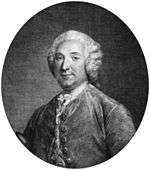Pierre Macquer
Pierre-Joseph Macquer (9 October 1718, Paris – 15 February 1784, Paris) was an influential French chemist.
Pierre-Joseph Macquer | |
|---|---|
 Pierre-Joseph Macquer | |
| Born | 9 October 1718 |
| Died | 15 February 1784 (aged 65) |
| Nationality | French |
| Known for | Dictionary of Chemistry |
| Scientific career | |
| Fields | Chemistry |
| Influences | Georges-Louis Leclerc, Comte de Buffon Guillaume-François Rouelle |
| Influenced | Antoine-Laurent de Lavoisier Geneviève Thiroux d'Arconville |
He is known for his Dictionnaire de chymie (1766). He was also involved in practical applications, to medicine and industry, such as the French development of porcelain. He worked as a chemist in industries, such as the Manufacture de Sèvres or the Gobelins Manufactory.[1] He was an opponent of Lavoisier's theories. The scholar Phillipe Macquer was his brother.
In 1752 Macquer showed that the pigment Prussian blue could be decomposed by alkaline solutions into a solid iron hydroxide compound and an aqueous solution of Ferrocyanide.[2][3]
In his 1749 Elemens de Chymie Theorique, Macquer builds on Geoffroy’s 1718 affinity table, by devoting a whole chapter to the topic of chemical affinity:[4]
All the experiments that have been hitherto carried out, and those that are still being daily performed, concur in proving that between different bodies, whether principles or compounds, there is an agreement, relation, affinity or attraction (if you will have it so), which disposes certain bodies to unite with one another, while with others they are unable to contract any union: it is this effect, whatever be its cause, which will help us to give a reason for all the phenomena furnished by chemistry, and to tie them together.
He became adjunct Chemist at the French Academy of Sciences the 5th of April 1745. He later became Associate Chemist in 1766 before being granted the permanent Chair of Chemistry in 1772.[5] In 1768, Macquer was elected a foreign member of the Royal Swedish Academy of Sciences.
Works
- 1756: Elemens de Chymietheoretique
- 1766: Dictionnaire portatif des arts et metiers, volume 1
- 1766: Dictionnaire portatif des arts et metiers, volume 2
References
- Lehman, C. (2012), 'Pierre-Joseph Macquer an Eighteenth-Century Artisanal-Scientific Expert' Annals of Science
- Macquer (1752). "Éxamen chymique de bleu de Prusse" [Chemical examination of Prussian blue]. Histoire de l'Académie royale des sciences … , § Mémoires de l'Académie royale des Sciences (in French): 60–77. From pp. 63-64: "Après avoir essayé ainsi inutilement de décomposer le bleu de Prusse par les acides, … n'avoit plus qu'une couleur jaune un peu rousse." (After having tried so vainly to decompose Prussian blue by acids, I made recourse to alkalies. I put a half ounce of this [Prussian] blue in a flask, and I poured on it ten ounces of a solution of nitre fixed by tartar [i.e., potassium nitrate (nitre) which is mixed with crude cream of tartar and then ignited, producing potassium carbonate]. As soon as these two substances had been mixed together, I saw with astonishment that, without the aid of heat, the blue color had entirely disappeared; the powder [i.e., precipitate] at the bottom of the flask had only a rather gray color: having put this vessel on a sand bath in order to heat the solution until it simmered, this gray color also disappeared entirely, and all that was contained in the flask, both the powder [i.e., precipitate] and the solution, had only a yellow color [that was] a little red.)
- Munroe, Charles E.; Chatard, Thomas M. (1902). "Manufactures: Chemicals and Allied Products". Twelfth Census of the United States: Bulletins (210): 1–306.; see p. 31.
- Macquer, P. J. (1775). Elements of the Theory and Practice of chymistry, trans. A. Reid, vol. 1. p. 12. 2 vols., London.
- Liste des membres du passé de l'Académie